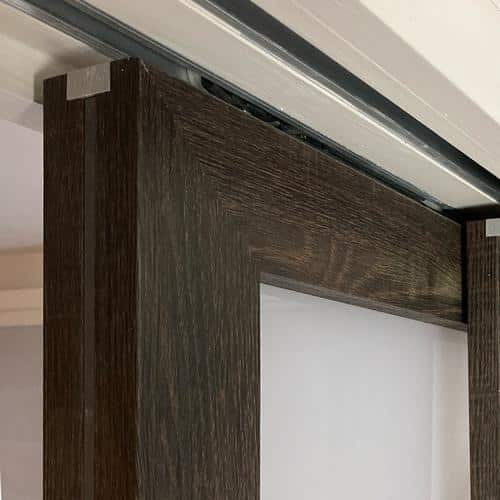Doors are often the start and last thing we see when entering a room, and that impression lasts long. More than just an entrance, a door plays a vital role in the style, mood and overall image of a space. From simple flat panels that blend seamlessly into elegant interiors to bold panels that frame a spacious hallway, door designs can subtly enhance or dramatically define the character of a room.
1.The Visual Impact: How Door Design Shapes the First Impression
At Haibo, we understand that visual harmony starts with the right form, finish, and detail. Our doors are crafted not only to function smoothly but also to complement a wide range of design visions.
• Door Style Sets the Tone
Wooden Door Factory may say: A paneled wooden door speaks tradition, while a flat slab with no visible grain signals minimalism. Arched tops or groove lines can add softness or drama depending on the room type.• Proportions Affect Perception
Oversized or full-height doors draw the eye upward, making ceilings feel taller. Narrower doors offer a cozier, more intimate feel—ideal for bedrooms or private offices.• Textures Create Visual Interest
Whether it’s a natural oak grain, a smooth lacquered finish, or a matte WPC surface, the texture of a door adds depth to walls and complements flooring and furniture.• Symmetry and Contrast in Interiors
Matching door colors with wall paint can create seamless transitions, while contrasting tones (e.g., a black door on a white wall) introduce bold modernity.
| Interior Style | Recommended Door Type | Key Features |
|---|---|---|
| Minimalist | Flush or flat-panel | Seamless, clean lines |
| Classic European | Raised panel, moldings | Decorative profiles, symmetry |
| Industrial | WPC with matte black trim | Dark tones, sturdy appearance |
| Scandinavian | Light wood grain | Simple shapes, natural texture |
| Contemporary | Glass inserts, sliding | Light flow, space-saving |
With Haibo’s wide range of PVC and WPC door designs, clients can find options that match both architectural and decorative goals. Every door is available in multiple finishes, panel patterns, and customizable sizes—making it easy to craft entrances that feel intentional and expressive.
Whether you're completing a residential renovation or outfitting a hotel suite, Haibo offers more than just functionality—we deliver visual harmony from the very started glance.
2.Functionality First: When a Door Enhances Comfort and Use
A beautifully designed door may please the eye, but its value is truly felt in daily use. In homes, offices, and commercial spaces, a door influences how people move, interact, and feel inside a room. The difference between a well-placed, smooth-swinging door and one that sticks, slams, or leaks sound is more than minor—it can shape a person’s entire experience in that environment.
-
This is where functional design becomes essential. A flush wooden door might bring visual calm to a hallway, but when it’s paired with soundproofing layers and quality hinges, it also adds quiet, privacy, and ease. A sliding WPC door may open up tight spaces in small apartments, creating better flow between rooms without sacrificing division. And in bathrooms or kitchens, doors that resist moisture and close securely without swelling make all the difference in comfort.
-
Even something as simple as the feel of a door handle – height, angle of rotation or surface finish – can affect ease of movement and perceived quality. For seniors and young children, Haibo offers doors that close easily, glide smoothly and are lightweight, ensuring ease of use for all ages and physical needs.
In high-traffic areas, doors need to be both durable and responsive. Imagine a hotel corridor with doors that open and close dozens of times a day: improperly installed doors can rattle, warp or wear out. Haibo solves this problem with core reinforcement technology and pressure-tested frames that are durable and built to withstand repeated use.

Ultimately, the functional doors are those you never notice in the moment—but always appreciate in the long run. At Haibo, functionality isn’t a side benefit—it’s built into every layer, from core structure to surface finish.
3.Light and Layout: How Glass, Texture, and Finish Affect Space Perception
Doors aren’t just physical dividers—they also play with light, texture, and finish to influence how a room feels in terms of openness, flow, and spatial definition. By selecting the right combination of materials and design elements, you can visually expand a small area, define functional zones within an open floor plan, or introduce warmth and depth into an otherwise flat space.
At Haibo, these principles are integrated into the door design process. Whether working with solid wood, engineered materials, or WPC compositions, each surface treatment and glass detail is thoughtfully chosen to contribute to the ambiance of a room.
How Doors Influence Light and Layout
• Glass Inserts Expand Visual Boundaries
Partial or full-glass door panels allow light to pass through interior walls, making adjacent rooms feel more connected and open. Frosted or tinted glass options offer privacy while still allowing natural brightness to filter in.• Matte vs. Glossy Finishes Affect Reflection
Glossy surfaces reflect light and can brighten darker corners of a room, while matte finishes absorb light, creating a more grounded and cozy effect.• Textured Surfaces Add Depth and Contrast
Wood grain patterns, brushed WPC textures, or vertical grooves create movement on an otherwise flat plane, enhancing wall and door transitions.• Directional Layout Enhances Room Proportions
Horizontal paneling can visually widen a narrow hallway, whereas vertical grain alignment draws the eye upward and emphasizes ceiling height.• Finish Colors and Door Width Shift Perception
Lighter colors help doors recede visually, nice for compact rooms. Wider doors with darker tones can anchor large open spaces, making them feel more structured and intentional.
4.The Psychology of Color: Choosing the Right Door Tone for the Right Mood
Color plays a powerful, often subconscious, role in how we experience spaces. While furniture, lighting, and wall tones all contribute to the mood of a room, the door—being both a functional and visual element—has a unique ability to influence how we feel when entering or exiting a space. The right door color can bring balance, contrast, energy, or calmness to a room, depending on the chosen tone and its relationship with surrounding finishes.
Common Color Associations in Interior Doors
• White & Light Neutrals
Symbolize clarity, cleanliness, and openness. Ideal for Scandinavian, coastal, or minimalist interiors. These tones help rooms feel more spacious and are often used in bedrooms or study areas to promote focus.
• Soft Greys & Taupe
These create a calming, sophisticated backdrop. They work well in transitional spaces or living rooms where neutrality is key, allowing furniture and art to take center stage.
• Warm Woods & Natural Tones
Rich oaks, walnuts, and cherry finishes bring warmth and comfort. They work beautifully in traditional settings and evoke feelings of security and timelessness.
• Black & Charcoal
Strong and grounded, these tones add drama and depth. They’re well-suited for modern or industrial-style interiors and often used as accent doors in hallways or kitchens.
• Muted Blues & Greens
These cool tones are associated with relaxation and balance. Often used in spa-like bathrooms or bedrooms, they provide a sense of serenity without overwhelming the space.
| Color Tone | Mood it Evokes | Best Room Use |
|---|---|---|
| Warm Wood | Comfort, Stability | Living Room |
| White | Clarity, Focus | Home Office |
| Dark Grey/Black | Depth, Boldness | Kitchen, Entryway |
| Sage Green | Calm, Freshness | Bedroom, Bathroom |
Choosing a color isn't just about matching furniture—it’s about reinforcing the emotional identity of a room. A bold-colored door can act as a centerpiece, while a subtle neutral one can serve as a soft transition point.
Haibo offers a curated palette of finishes designed to suit different personalities and space types. Our design consultants often work with clients to select tones that reflect not only their taste but also the mood they wish to invite into their homes.
5.Beyond the Doorframe: Why Craftsmanship and Material Quality Matter
There’s more to a door than meets the eye. While design is often apparent at beginning glance, it’s the unseen elements that really determine a door’s performance – the consistency of materials, precision joinery, interlocking of moldings and finishes. True craftsmanship lies in combining aesthetics with engineering to create a door that feels solid, opens smoothly and lasts.
1.At Haibo, we believe that quality doors begin with the selection of raw materials. Each wood or wood-plastic composite door core is tested for density, grain uniformity and moisture resistance. Poor-quality door cores often cause to warping, cracking or swelling, especially in areas with seasonal climate changes. To avoid this, we use kiln-dried wood and moisture-tested composite materials for added strength and dimensional stability.
2.Craftsmanship also means meticulous attention to detail. Perfectly sanded edges, seamless panel seams, aligned groove patterns and invisible reinforcements are all hallmarks of a quality door. You can’t see them in product photos, but you can feel them every time you open and close – quietly, balanced, and smoothly locking.
3.Surface treatment is another critical aspect. A well-sealed surface can effectively protect against UV rays, moisture and dust. Whether the door is painted, veneered or laminated, the quality of the bonding and coating determines not only its appearance but also its durability.

Haibo’s production team blends precision machining with hand-finished care. Our facilities are equipped with advanced CNC cutters, but our final inspections are done by experienced craftsmen who know when a door feels right—not just measures right.
When quality matters beyond stared impressions, investing in materials and trustworthy workmanship makes all the difference. With Haibo, you get doors that are not only visually refined but structurally dependable—an investment in peace of mind, room after room.

 English
English русский
русский Français
Français Español
Español bahasa Indonesia
bahasa Indonesia عربى
عربى



